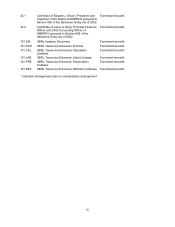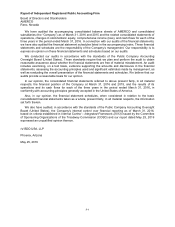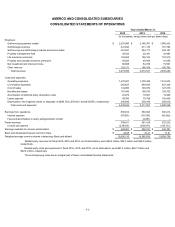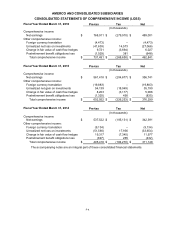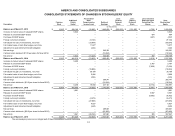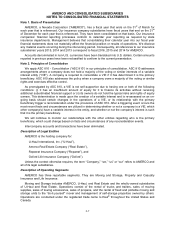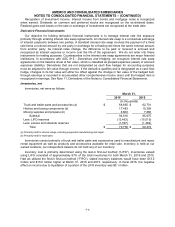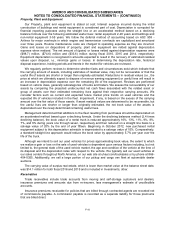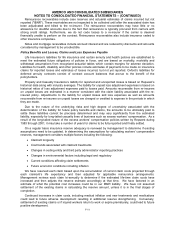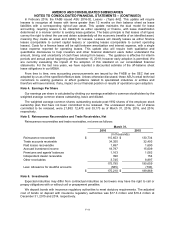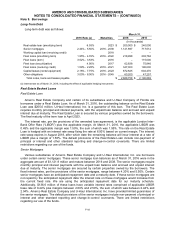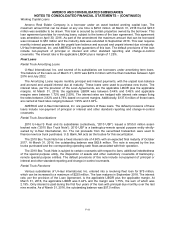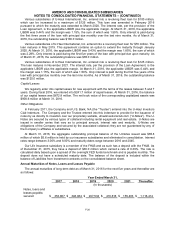U-Haul 2016 Annual Report Download - page 66
Download and view the complete annual report
Please find page 66 of the 2016 U-Haul annual report below. You can navigate through the pages in the report by either clicking on the pages listed below, or by using the keyword search tool below to find specific information within the annual report.AMERCO AND CONSOLIDATED SUBSIDIARIES
NOTES TO CONSOLIDATED FINANCIAL STATEMENTS – (CONTINUED)
F-10
Property, Plant and Equipment
Our Property, plant and equipment is stated at cost. Interest expense incurred during the initial
construction of buildings and rental equipment is considered part of cost. Depreciation is computed for
financial reporting purposes using the straight line or an accelerated method based on a declining
balance formula over the following estimated useful lives: rental equipment 2-20 years and buildings and
non-rental equipment 3-55 years. We follow the deferral method of accounting based on ASC 908 -
Airlines for major overhauls in which engine and transmission overhauls are capitalized and amortized
over three years. Routine maintenance costs are charged to operating expense as they are incurred.
Gains and losses on dispositions of property, plant and equipment are netted against depreciation
expense when realized. The net amount of (gains) or losses netted against depreciation expense were
($98.7) million, ($74.6) million and ($33.6) million during fiscal 2016, 2015 and 2014, respectively.
Equipment depreciation is recognized in amounts expected to result in the recovery of estimated residual
values upon disposal, i.e., minimize gains or losses. In determining the depreciation rate, historical
disposal experience, holding periods and trends in the market for vehicles are reviewed.
We regularly perform reviews to determine whether facts and circumstances exist which indicate that
the carrying amount of assets, including estimates of residual value, may not be recoverable or that the
useful life of assets are shorter or longer than originally estimated. Reductions in residual values (i.e., the
price at which we ultimately expect to dispose of revenue earning equipment) or useful lives will result in
an increase in depreciation expense over the remaining life of the equipment. Reviews are performed
based on vehicle class, generally subcategories of trucks and trailers. We assess the recoverability of our
assets by comparing the projected undiscounted net cash flows associated with the related asset or
group of assets over their estimated remaining lives against their respective carrying amounts. We
consider factors such as current and expected future market price trends on used vehicles and the
expected life of vehicles included in the fleet. Impairment, if any, is based on the excess of the carrying
amount over the fair value of those assets. If asset residual values are determined to be recoverable, but
the useful lives are shorter or longer than originally estimated, the net book value of the assets is
depreciated over the newly determined remaining useful lives.
Management determined that additions to the fleet resulting from purchases should be depreciated on
an accelerated method based upon a declining formula. Under the declining balances method (2.4 times
declining balance), the book value of a rental truck is reduced approximately 16%, 13%, 11%, 9%, 8%,
7%, and 6% during years one through seven, respectively and then reduced on a straight line basis to a
salvage value of 20% by the end of year fifteen. Beginning in October 2012, new purchased rental
equipment subject to this depreciation schedule is depreciated to a salvage value of 15%. Comparatively,
a standard straight line approach would reduce the book value by approximately 5.7% per year over the
life of the truck.
Although we intend to sell our used vehicles for prices approximating book value, the extent to which
we realize a gain or loss on the sale of used vehicles is dependent upon various factors including, but not
limited to, the general state of the used vehicle market, the age and condition of the vehicle at the time of
its disposal and the depreciation rates with respect to the vehicle. We typically sell our used vehicles at
our sales centers throughout North America, on our web site at uhaul.com/trucksales or by phone at 866-
404-0355. Additionally, we sell a large portion of our pickup and cargo van fleet at automobile dealer
auctions.
The carrying value of surplus real estate, which is lower than market value at the balance sheet date,
was $14.1 million for both fiscal 2016 and 2015 and is included in Investments, other.
Receivables
Trade receivables include trade accounts from moving and self-storage customers and dealers,
insurance premiums and amounts due from re-insurers, less management’s estimate of uncollectible
accounts.
Insurance premiums receivable for policies that are billed through contracted agents are recorded net
of commissions payable. A commission payable is recorded as a separate liability for those premiums
that are billed direct.


